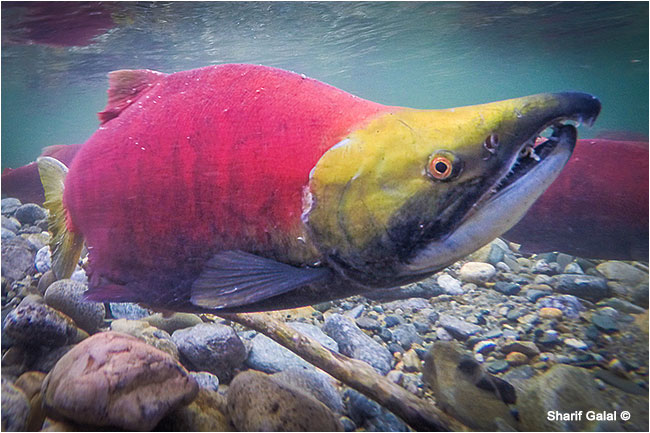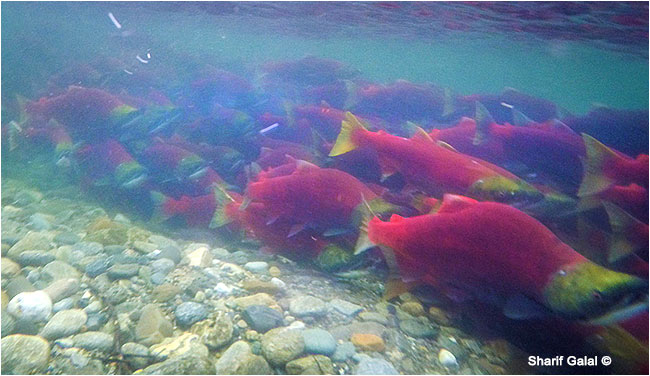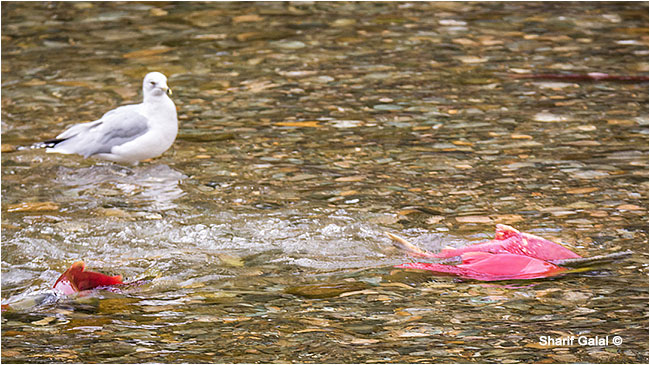
The Great Salmon Run in Adams River BC
by Dr. Sharif Galal
October 21, 2014
Since I was a little kid, I was always fascinated by nature and I knew about Canada from the nature documentaries before I moved and settled here. I still remember one of those shows about the great salmon migration. It has always been a dream to watch the salmon run and this dream came true this year when my fellow (Ahmed ElWakil) and I decided to drive to Chase, BC to watch this great event last week.
We headed toward Broderick Haig-Brown Provisional Park which is about 6 hours driving from Calgary.
Every four years , the banks of Adams river hosts one of the nature greatest events “As described by Sir David Attenborough” where millions of Sockeye Salmon migrates all the way from the pacific ocean where they have spent their adult life to reach their original home to complete the life cycle by spawn and die after.
When the migration starts, the salmon is silver in color. This color changes to red when they reach their final destination, in addition to that, their heads turn pea green and the males develop large jaws and prominent teeth. Once they entered the fresh water, they don’t eat till they spawn and die. The trip takes about 17 days where they migrate about 500 km
When we reached there, the river was almost crimson because of the significantly large number of salmon this year.
After the long journey, the male`s jaw and teeth enlarges in order to fight other males who are venturing too close while his female digging the nest and lying on her side flapping her tail to drop her eggs. The place has to be clean, slit free gravels in moving water so the eggs will receive the necessary oxygen to survive. Eggs look pink-orange in color and the moment they laid, the male or some times more males, will release their sperms to fertilize the eggs. The process continues till they get exhausted and die.
The eggs stay in the river bed until January when they start to hatch , by April , the small fish migrate to Shuswab lake where they remain to feed and grow till the following spring when they migrate to the pacific ocean.
Sockeye salmon return every year to this place but every 4th year is considered a dominant year where the number of migrated salmon are much higher.
After laying eggs the salmon under programmed cell death and die.
This Seagull was waiting for the moment they lay their eggs to eat some.
They die after several cycles of laying eggs
Sharif Galal and friend Ahmed ElWakil
Euipment used:
Underwater camera : GoPro Hero 4
Other photos : Nikon D7100 and Nikkor 50mm 1.8 with CPL filter
Canon T3i with Canon 24-105
Dr. Sharif Galal is a medical doctor and a researcher of lung diseases at the University of Calgary. He received his M.D. from Egypt and his specialty degree in diving medicine from Stellenbosch University- South Africa in addition to a Master’s degree in biomedical sciences from university of Calgary. Apart from medicine and research, Dr. Galal is an amateur underwater photographer, scuba diving instructor and an enthusiastic wildlife and nature advocate. He currently resides in Calgary, Alberta and can be contacted at:
www.facebook.com/sharifgalalphotography
View previous articles by Dr. Galal
The Great Grey Owl (Strix nebulosa)
Rocky Mountain MarmotLinks to additional resources
- Adams River Salmon Society - weekly updates
- Shuswap tourism places to view the salmon
- Roderick Haig-Brown Provincial Park - Sockey Salmon Festivial
- Map to Adams River - 585 Km from Calgary - approximately 7 and half hour drive.
[ Top ]










.jpg)
.jpg)

